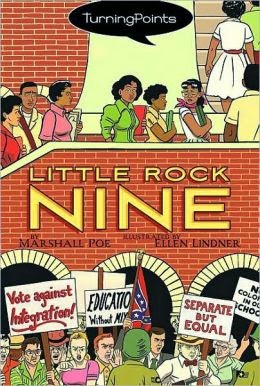Turning Points is a series of graphic novels from Aladdin Paperbacks, that tell about important moments and events in US history. These books are portable and affordable, and I have had them on my "to read" pile for a while now, so there is no time like to present to see how good they are. All three of these books I review below were written by Marshall Poe, a writer and historian known for his work at The Atlantic and also as editor in chief of the New Books Network.
There is more nuance when looking at Thomas Johnson's family. He is a 15 year old black boy, and he took part in an attempt to integrate the schools the year prior. Of course, he wants to be treated equally, but he and his family have experienced the intense backlash from those who want to keep things as it was, and they are hesitant to deal with all the potential degradation and violence that came with social action. I appreciated that civil rights issues were here considered with more attention to the context, because I think for some students these matters are such cut and dried, facile decisions and I feel they should see how much of an actual struggle such change was.
All the reviews I have read about Little Rock Nine have been positive. Snow Wildsmith wrote, "Poe’s insistance [sic] on showing as many sides of a story as possible
succeeds admirably here, resulting in two main character [sic] who are
believable boys caught up in a storm they don’t quite understand and
aren’t sure that they’re strong enough to face." The folks at the Historical Novel Society called it "exciting and historically accurate." Marya Jansen-Gruber offered this opinion, "This format will encourage young readers to ask questions about the
civil rights movement, and the book will provide an excellent platform
for a class segment about the Little Rock Nine."
The art in this volume is by Ellen Lindner. She is a cartoonist and illustrator known for her Ignatz Award nominated webcomic The Black Feather Falls and various other comics projects. Her artwork is somewhat cartoonish, but her storytelling is very clear. I also admire her ability to depict the emotions through her figures' faces and postures.

The artwork in the next two books is by Leland Purvis, whose other graphic novel works include the Resistance trilogy and a biography of Neils Bohr. His work in this volume is a combination of strong ink lines and sketch-like illustrations. I think he captures the historical flavor through costumes and backgrounds, though sometimes it is difficult to keep track of which character is which.
Sons of Liberty follows a period of US history from 1768-1776, a time of great change and a number of historical events leading up to the American Revolutionary War. The entryway into this story is Nathaniel Smithfield, a fictional apprentice to Paul Revere. He is ten years old when the book begins, and over time he meets a number of prominent patriots, including Sam Adams and John Hancock, and is witness to many events, such as the Boston Tea Party and combat in the battles of Lexington and Concord. Although this book is a piece of historical fiction and uses much original dialogue, there are a number of sections based in real accounts that feature first-hand descriptions of events.
 |
| Nathaniel throws a pretty mean rock. |
The drama in this story is heightened by family tensions, with Nathaniel butting heads with his Loyalist father. In a clever way, this familial conflict mirrors the thought process of the colonists to rebel against England, and over time, the family dynamics shift and events cause people's minds to change. Even though I was pretty familiar with the actual events, I felt myself becoming concerned for the characters' lives. There is a lot to digest in the book, in terms of the sheer amount of facts, events, and characters, but I feel that the story is quite compelling and interesting.
The reviews I have read about Sons of Liberty are pretty mixed. Snow Wildsmith felt that this book was relatively weak, "mainly due to Poe attempting to cover too much time in too short of a book." The Historical Novel Society commented positively that it "gets to the heart of what it felt like to be a young boy in the middle
of a thrilling period of history, with its conflicts, agreements and
world-changing events." The Breed's Hill Institute summed it up as "an imperfect but interesting taste of history."
The dual narratives shows two very different paths on the road to abolishing slavery, and there are a great many events enumerated in the storytelling. In addition, Purvis's artwork is less sketchy than in Sons of Liberty and includes more grey tones, which give it a more painterly sheen. The sum total of these features is an engaging set of tales that balance historical import with human emotion.
I was not able to find many reviews of A House Divided, but Snow Wildsmith praised it particularly because "one of the strongest points of this book (and of the series) is that Poe doesn’t neglect to tell both sides of a story as much as he can" and because "Purvis’ art is also stronger in this volume." I agree with her on both counts.
Previews and more information about all these Turning Points books can be found here from their publisher.



No comments:
Post a Comment